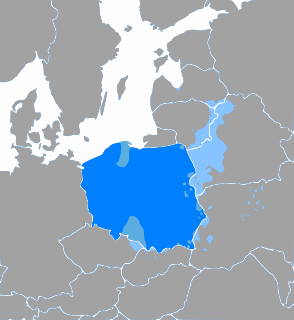
Red Ruthenia or Red Rus' (Latin: Ruthenia Rubra; Russia Rubra; Ukrainian: Червона Русь, translit. Chervona Rus'; Polish: Ruś Czerwona, Ruś Halicka; Russian: Червонная Русь, translit. Chervonnaya Rus') is a term used since the Middle Ages for a region now comprising south-eastern Poland and adjoining parts of western Ukraine. It has also sometimes included parts of Lesser Poland, Podolia, "Right-bank Ukraine" and Volhynia. Centred on Przemyśl (Peremyshl), it has included major cities such as: Chełm, Zamość, Rzeszów, Krosno and Sanok, as well as Lviv and Ternopil.

The Ruthenian Voivodeship was a voivodeship of the Crown of the Kingdom of Poland from 1434 until the 1772 First Partition of Poland. with a center in the city of Lviv. Together with a number of other voivodeships of southern and eastern part of the Kingdom of Poland, it formed Lesser Poland Province of the Polish Crown, with its capital city in Kraków. Following the Partitions of Poland, most of Ruthenian Voivodeship, except for its northeastern corner, was annexed by the Habsburg Empire, as part of the province of Galicia. Today, the former Ruthenian Voivodeship is divided between Poland and Ukraine.

Jan Amor Tarnowski was a Polish nobleman, knight, military commander, military theoretician, and statesman of the Crown of the Kingdom of Poland. He was Grand Crown Hetman from 1527, and was the founder of the city of Tarnopol, where he built the Ternopil Castle and the Ternopil Pond.

Count Jan Klemens Branicki was a Polish nobleman, magnate and Hetman, Field Crown Hetman of the Polish-Lithuanian Commonwealth between 1735 and 1752, and Great Crown Hetman between 1752 and 1771. One of the wealthiest Polish magnates in the 18th century, owner of 12 towns, 257 villages and 17 palaces. He was the last male representative of the Branicki family.

A sejmik was one of various local parliaments in the history of Poland. The first sejmiks were regional assemblies in the Kingdom of Poland, though they gained significantly more influence in the later era of the Polish–Lithuanian Commonwealth. Sejmiks arose around the late 14th and early 15th centuries and existed until the end of the Commonwealth in 1795, following the partitions of the Commonwealth. In a limited form, some sejmiks existed in partitioned Poland (1795–1918), and later in the Second Polish Republic (1918–1939). In modern Poland, since 1999, the term has revived with the voivodeship sejmiks, referring to the elected councils of each of the 16 voivodeships.

Hetmans of the Polish–Lithuanian Commonwealth were the highest-ranking military officers, second only to the King, in the Polish–Lithuanian Commonwealth. The first Polish title of Grand Crown Hetman was created in 1505. The title of hetman was given to the leader of the Polish Army and until 1581 it was awarded only for a specific campaign or war. Later it became a permanent title, as did all the titles in the Kingdom of Poland and Polish–Lithuanian Commonwealth. It could not be revoked unless treachery had been proven. Hetmans were not paid for their services by the Royal Treasury.

Bełz Voivodeship was a unit of administrative division and local government in Poland from 1462 to the Partitions of Poland in 1772–1795. Together with the Ruthenian Voivodeship it was part of Red Ruthenia, Lesser Poland Province of the Polish Crown. The voivodeship was created by King Kazimierz Jagiellonczyk, and had four senators in the Senate of the Commonwealth.

The Kiev Voivodeship was a unit of administrative division and local government in the Grand Duchy of Lithuania from 1471 until 1569 and of the Crown of the Kingdom of Poland from 1569 until 1793, as part of Lesser Poland Province of the Polish Crown.

Franciszek Salezy Potocki (1700–1772) was a Polish nobleman. Knight of the Order of the White Eagle, awarded on August 3, 1750 in Warsaw. The richest magnate of his time, owner of huge properties in the Dnipro Ukraine. Nicknamed "Little King of Ruthenia".
Castellans of the Polish–Lithuanian Commonwealth were the lower rank officials who could sit in the Senate of Poland. Their numbers varied with time and shifting borders of the Commonwealth.
Stanisław Salmonowicz is a Polish historian, professor of the Nicolaus Copernicus University in Toruń, and a member of the Polish Academy of Learning and History Institute of the Polish Academy of Sciences.
Mikołaj Złotnicki was King's Cup-Bearer of the Crown since 1688.

Aleksander Kazimierz Sapieha was a Polish nobleman. He became bishop of Samogitia in 1660 and of Vilnius in 1667.

Michał Wielhorski h. Kierdeja was a Polish noble, official, politician, diplomat and writer. He was the Lithuanian Master of the Kitchen in the years 1763–1774, Lithuanian Great Quartermaster in 1758–1762, starost and envoy of the Bar Confederation to France.

John Chojeński was a sixteenth-century Polish bureaucrat and church leader. and beatified person.

Samuel Maciejowski was a 16th-century Roman Catholic Bishop of Chełm, Płock and Kraków, in Poland.

Silesian County was an administrative unit (powiat) of both the Kingdom of Poland and the Polish–Lithuanian Commonwealth. With seats in the towns of Zator and Oświęcim, it was part of Kraków Voivodeship.
Aleksander Dzierzbicki was a Polish szlachcic (nobleman), a chorąży of Inowłódz (1752-1759), a chorąży mniejszy łęczycki (1759), a chorąży większy łęczycki (1759-1763) and a castellan of Brzeziny (1763-1767).
Mikołaj Święcicki of the Jastrzębiec coat of arms was from 1697, the Bishop of Kiev, from 1699, the Bishop of Poznań, the chancellor of the Poznań cathedral chapter in 1674-1679, the dean of the Poznań cathedral chapter in 1679-1701 scholastic of the collegiate chapter of Saint. John the Baptist in Warsaw, an official and vicar general in Mazovia in 1684.














